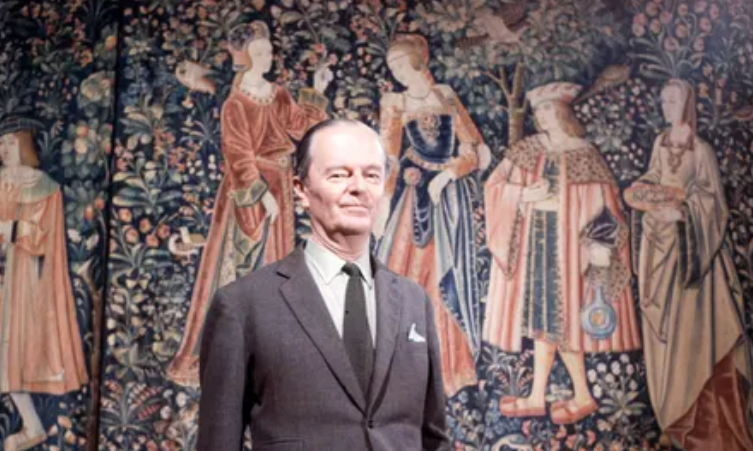
We now enter the era of the High Gothic, a time of chivalry, courtly love, and romance amongst the elite, enjoying an often tenuous relationship with reality. Indeed, “even war and theology could become a sort of game,” and “architecture reached a point of extravagance unequalled in history.” It was a period that “produced some of the greatest spirits in the history of humanity,” including St Francis of Assisi and Dante. Beginning at the Cluny Museum, Sir Kenneth Clark (above) examines the aspirations and achievements of the later Middle Ages in 14th century France and Italy.
FANTASY & REALITY
Different Planes: Clark stresses a vital insight about different forms of reality:
behind all the fantasy of the Gothic imagination there remained, on two different planes, a sharp sense of reality. Medieval man could see things very clearly, but he believed that these appearances should be considered as nothing more than symbols or tokens of an ideal order, which was the only true reality.
The Lady & the Unicorn: This dualistic orientation to the world is exemplified by The Lady and the Unicorn (c.1500), a series of tapestries from the Cluny Museum, and “one of the most seductive examples of the Gothic spirit.” On the surface, it’s concerned with the four senses. However, at a deeper level, “its real subject is the power of love, which can enlist and subdue all the forces of nature, including those two emblems of lust and ferocity, the unicorn and the lion,” which each pay homage to the lady.
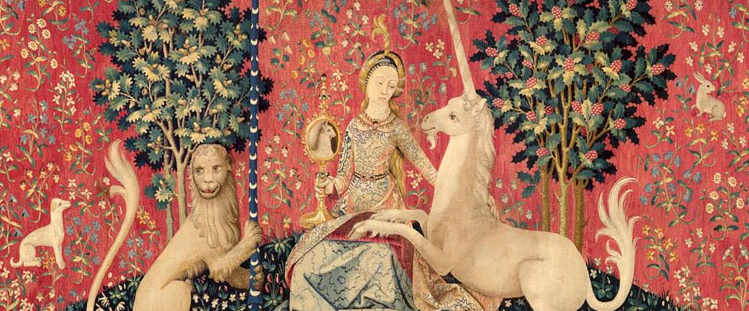
Progression: Such images imply a progression from the earnest and solemn state of mind that built Chartres Cathedral. However, “the notion of ideal love and the irresistible power of gentleness and beauty” can be traced back three centuries and found on the north portal of Chartres, decorated around 1220 under the sponsorship of Blanche of Castile, the queen consort of France. This features “one of the first consciously graceful women in Western art.” The “self-conscious refinement” of such portrayals contrasts radically with the “squat, bad-tempered viragos” accompanying the Norsemen depicted in previous art. Other figures on the portico provide, “almost for the first time in visual, a sense of human rapport between man and woman.”
COURTLY LOVE
Nonplussed: Clark is nonplussed by this sudden emergence of the ideal of courtly love: “this state of utter subjection to the will of an almost unapproachable woman; this belief that no sacrifice was too great, that a whole lifetime might properly be spent in paying court to some exacting lady, or suffering on her behalf.” It was an ideal that would have been absurd and unbelievable to the Romans of Europe’s past or the Vikings of its present, “and yet for hundreds of years it passed unquestioned and inspired a vast literature” and a rich canon of art.
Mysterious Origins: Clark acknowledges that the origins of this ideal are shrouded in mystery, although he recognizes the role of the troubadours and the peculiar position of the lady of the castle. Left in charge while her husband was away for years on crusade (from which he might never return), she was surrounded by under-employed but energetic young knights. He cites the many versions of The Siege of the Castle of Love – delicate and highly detailed ivory carvings (one which is below) depicting the ladies on the battlements “putting up a weak defence as young gallants climb up on rope ladders.”
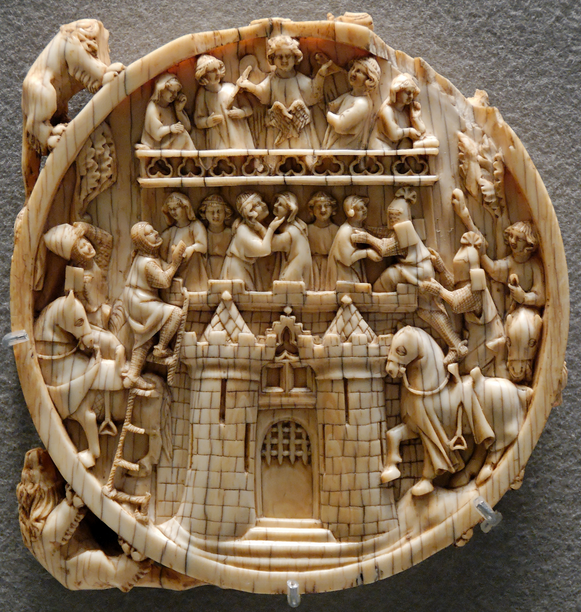
Mariology or Heresy Nevertheless, it is possible to identify a number of other, more edifying, influences that shaped this phenomenon. For example, the new Marian theology placed an emphasis on a strong devotion to the Virgin Mary along with disinterested spiritual love that approximates the courtly kind. Alternatively, it may have reflected the persistence of pre-Christian attitudes towards women and sexuality, or even the Cathar heresy, before it was wiped out by the Albigensian Crusade of the 13th century.
Islamic Mysticism Clark also acknowledges the influence of heterodox Islamic ideas brought back from the Crusades. For example, Sufi love poetry employed erotic metaphors that were very similar to courtly rhetoric: a special lady was endowed with every aspect of beauty, elevated beyond human grasp, and unconditionally adored but never attained. This was a this-worldly symbol of the other-worldly Divine, unity with which was the aim of the mystics’ endless quest.
The Romance of the Rose: Whatever its origins, this ideal of courtly love produced some sublime art and literature, including the Arthurian Mythos and The Romance of the Rose. It also found later expression in Romanticism. Ultimately, Clark asks: “Were there ever more delicate creatures than the ladies on Gothic ivories?”
GREAT PATRONS OF ART
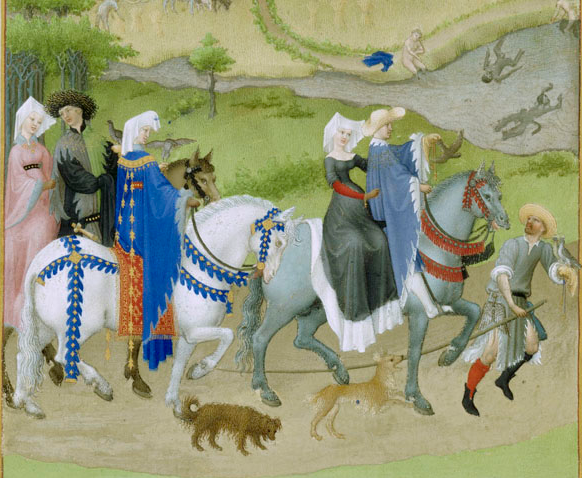
Royal Brothers: Clark then turns to some great patrons of art – four brothers: King Charles V of France; the Duke of Burgundy; Louis d’Anjou; and John, Duke of Berry. The latter committed his entire life to the arts, procuring a vast collection, including many paintings and books, which survives. This reveals a good deal about the civilisation of the late 14th century, e.g., “the delicacy and refinement of the 13th century lasted over 100 years”; “the sweet new style of the Gothic ivories became sweeter and softer”; and there was an increase in subtlety that compensated for a loss of “spring and tension”.
Natural Subjects: The Duke’s collection also reveals the emergence during the 14th century of an artist preoccupation with natural subjects, seen always in isolation, and especially birds. These were a “medieval obsession” that came to represent souls flying up to God; and freedom to roam in a world where the mass of people were tied to the land under feudal conditions.
The Limbourgs: The Duke also discovered the Limbourg brothers from Nijmegen. They worked in the style of International Gothic and created a famous late medieval illuminated manuscript, The Very Rich Hours of the Duke of Berry ~ “one of the miracles of art history”, Clark observes. A book of hours, it contains over 130 invaluable images depicting courtly and everyday life of the time, painted by the Limbourgs and later artists.
Petrification: The courtly society represented in such works became fashionable across Europe, but it “wasn’t enough to keep a civilization alive”: it depended on a small static and insular elite that lived entirely in the present, and that tended to become “entirely petrified” and anxious only to hold onto its own status and privileges.
Dynamism: In contrast,
…the great, indeed the unique, merit of European civilization has been that it has never ceased to develop and change. It has not been based on a stationary perfection, but on ideas and inspiration.
It was this dynamism rather than the complacency of the courts that would usher in the Renaissance and the rise of modern Europe.
FRANCIS OF ASSISI
Epiphany: Clark then turns to “a rich young dandy named Francesco Bernadone” and the profound religious experience that transformed him into Francis of Assisi (1182-1226). He recounts Francesco’s encounter with a poor man to whom he gave his cloak and his subsequent dream that revealed to him that he should give away all his possessions and rebuild the Celestial City. After his father disowned him he discarded all his clothes and “went off into the woods, singing a French song.” He spent the next three years in abject poverty, looking after lepers and rebuilding derelict churches. He took the Gospels literally and translated them into chivalric poetry and songs. He declared he had “taken poverty for his Lady,” and began to attract a devoted following, galvanized by his sincerity and asceticism.
Genius & Heresy: As Clark observes, “from the first everyone recognized that St Francis was a religious genius ~ the greatest, I believe, that Europe has ever produced.” Although he was a layman with no theological training, Pope Innocent III permitted him to found a religious order and canonized him shortly after his death at age 43 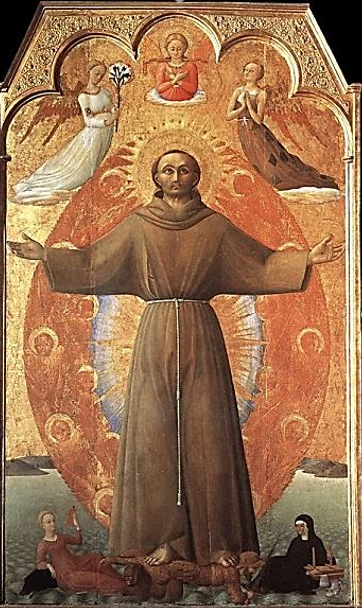 “worn out by his austerities.” The Franciscans quickly became one of the most dynamic and important of all Christian orders. However, its commitment to absolute poverty brought condemnation from a Church hierarchy deeply embedded in the financial and economic establishment, and the more fanatical Franciscans, the Fraticelli, were denounced as heretics and many burnt at the stake.
“worn out by his austerities.” The Franciscans quickly became one of the most dynamic and important of all Christian orders. However, its commitment to absolute poverty brought condemnation from a Church hierarchy deeply embedded in the financial and economic establishment, and the more fanatical Franciscans, the Fraticelli, were denounced as heretics and many burnt at the stake.
Artistic Depictions: Reviewing the many works devoted to St Francis, Clark believes the best are by the Sienese painter, Sassetta, which depict key episodes from the saint’s life (one of which is at left), and convey an appropriate “sprightly, lyrical, and visionary quality.” He notes also Giotto’s works but feels they make St Francis seem “too grave and commanding.” Most importantly, there was the great basilica constructed by his followers that became “a masterpiece of Gothic architecture, decorated by all the chief Italian painters of the 13th and 14th centuries.” It also became the richest church in Italy – a strange memorial to the little poor man and his cult of poverty.
Prophet: St Francis drove an extremely influential idea deeply into the European consciousness ~ that we must shed all our earthly goods if we are to achieve spiritual liberation. This idea “gained a new meaning in the 18th century through the philosophy of Rousseau and Wordsworth,” and many others.
GIOTTO & EARLY CAPITALISM
Capitalism: Nevertheless, Clark believes, St Francis remains “a figure of the pure Gothic time,” of crusades, chivalry, castles, and great cathedrals. Around him “another world was growing up, the ancestor of our own, a world of trade, banking and early capitalism.” Its “hard-headed men” were realists, not idealists, and they were not interested in poverty — “their aim in life was to grow rich without ceasing to appear respectable.” They demanded a different sort of art.
Revolution These new merchant classes called forth a revolution in aesthetics
as patrons of their own time, were at least as intelligent as the aristocracy. And just as their economic system was capable of expansion that has lasted till today, so the painting they commissioned had a kind of solid reality that was to be the dominant aim of Western art up to the time of Cézanne.
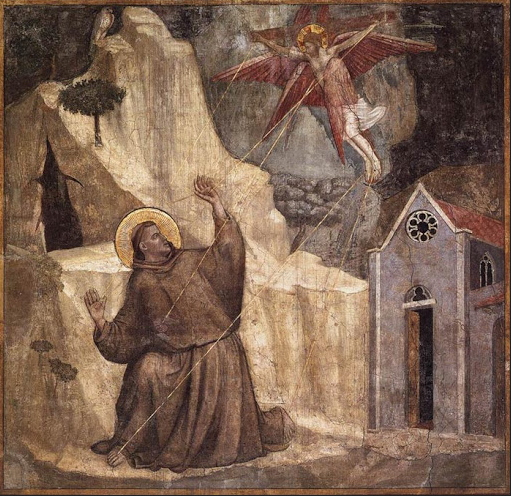
The Third Dimension: The vital step was to create images that communicated a sense of space, that broke out of the conventional two dimensions of all painting hitherto, and ventured into three dimensions, within which startling new forms of realism could be achieved. And the key figure here was Giotto (one of his St Francis paintings above), who communicated space, solidity, and humanity, and became
one of the greatest masters of painted drama that has ever lived.” His breakthrough “was one of those feats of inspired originality that have occurred only two or three times in the history of art.”
The Arena Chapel: Giotto seems to have burst upon the scene in 1304 when he
decorated a small plain building in Padua known as the Arena Chapel (below), and made it, to anyone who cares about painting, one of the holy places of the world.
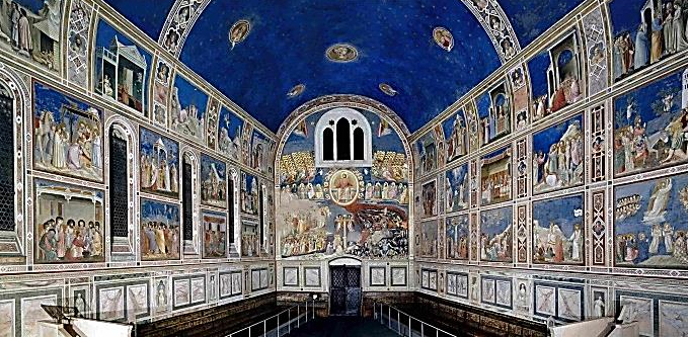
The commission was from a money-lender “as a kind of atonement”, and Giotto completed other work for bankers, including several who lost everything when King Edward III defaulted and precipitated “one of the first classic crashes in the history of capitalism.”
DANTE & PISANO
Divine Comedy: Clark turns finally to Dante, whose Divine Comedy made him, “the greatest philosophic poet that has ever lived.” Written in the vernacular, the immense poem is divided into three parts: Inferno, Purgatorio, and Paradiso, describing Dante’s travels through the realms of the afterlife. He is guided first by Virgil (representing Classical culture and reason) and then, when he can go no further, by Beatrice (representing Christian culture and revelation). Along the way, Dante engages in conversation with various saints, and famous sinners whose fates, he makes clear, were of their own making. At the literal level, the poem offers a detailed depiction of the medieval Christian worldview as articulated by Aquinas, while allegorically it represents the soul’s journey towards God.
Two Worlds: Dante and Giotto lived at the conjunction of two realms: one, the ethereal Gothic realm of Scholasticism, great cathedrals, theological abstractions, and the search for the divine; the other, the new worldly mercantile realm of money, trade, concrete humanity, and the pursuit of profit.
 Unearthly Vision: As his world passed away, Dante revealed qualities that, for all Giotto’s greatness, he would lack:
Unearthly Vision: As his world passed away, Dante revealed qualities that, for all Giotto’s greatness, he would lack:
Philosophic power, a grasp of abstract ideas, moral indignation, that heroic contempt for baseness that was to come again in Michelangelo; and above all, a sense of the unearthly, a vision of heavenly radiance.
Pisano: Clark believes that the spirit of Dante was captured by sculptor Giovanni Pisano, “one of the great tragic dramatists,” whose work, like Dante’s Inferno, “depicts a terrible world of hatred, cruelty and suffering,” to which Dante consigns those who ever crossed him. (at right, Pisano’s Christ)
Light: But that was only one side of Dante, for his poetry contains “moments of disembodied bliss to which no artist of the time did justice.” Like all the other heroes of Civilisation, “Dante thought of light as a symbol of the spiritual life” refracted through our material realm. But this can provide only similes
intended only to illustrate and make comprehensible to our earth-bound senses a vision of divine order and heavenly beauty.
Our inquiry into such things continues next week.
Appendix: The Spiritual Revolution of the High Middle Ages
Spiritual Shift: The High Middle Ages saw a major shift in the collective religious consciousness of the West. This involved a greater emphasis on the shared ‘humanness’ of human beings and God, and also saw the emergence of a messianic view of history that has survived to the present day. St Bernard of Clairvaux and St Francis of Assisi played major roles in this shift.
Humanity: Firstly, there emerged a deep concern with the human agony suffered by Jesus on the Cross (possibly a reflection on the endemic misery and violence in society). In the 10th Century a typical icon would represent Christ as the distant King in Majesty, the terrible and austere judge of a sinful humanity. However, in the 12th Century, a typical icon would depict Jesus as the Crucified Christ, a tortured human being suffering on the Cross to save humanity from sin.
Veneration of Mary: Accompanying this shift was a marked increase in the popular veneration of Mary as the Mother of God, the highest symbol of female spirituality in the Christian faith. This was particularly prominent in monasteries, but such devotion also found general expression in various forms of popular piety, prayer, pious acts, feast days, the visual arts, poetry, chanting, and music. After 1000, many of Europe’s greatest cathedrals were dedicated to Mary, including Notre Dame de Paris as well as Our Lady of Chartres. And, at the height of the pilgrimage movement in the 11th and 12th Centuries, masses of people were traveling almost constantly from monastery to monastery and one Marian shrine to the next. There was a clear demand for a benevolent, nurturing, and intimate relationship with the Divine, and a desire that that realm have a deeply human quality about it.
Demand for Reform: Such shifts in spiritual consciousness demanded significant reforms in Church and monastic life, following the Gregorian Reforms of the 11th Century, which had attempted to reclaim the Church from the notorious ‘Rule of Harlots’ into which it declined in the 10th Century. These were accompanied by the Cluniac Reforms to the monasteries. These began within the Benedictine Order at Cluny Abbey, and spread throughout France, England, and much of Italy and Spain.
Disillusionment: It became clear that the Order had allowed itself to become far too slack and undemanding of its monks, many of whom did little useful work and lived in comparative luxury. There was widespread corruption and growing disillusionment amongst the masses at the way the monasteries had betrayed their sacred duty to provide spiritual protection for their communities, through their prayers and devotions. Reform was made even more urgent by a sharp decline in numbers of monks entering the monasteries.
The New Orders: In response to these crises two new religious Orders emerged between 1075 and 1125: the Cistercians and the Augustinians. One sought reform, the other, revolution:
While the Cistercians sought to revive the original Rule of St Benedict, which his followers were alleged to have abandoned, the Augustinians sought to revive something that went behind the Rule, behind even the organized church – back to the Bible. —R.W. Southern, Western Society & the Church
That is, they wished to recall, the simple communal living of the Early Church before Christianity was made the State religion of the Roman Empire.
Two Types of Religious Life: Writing at the time, Pope Urban II declared the Early Church offered two forms of religious life: the monastic and the canonical. The monastic offered an escape from the world into contemplation on God and His Word; the canonical involved a plunge into the world and close engagement with its problems. The desire to retreat from the world had benefited the Benedictines; the newly emerging desire to engage with the world prompted the advent of the Augustinians.
The Cistercians: The problem for the monastic ideal was that the Benedictines had become moribund. Consequently, this called forth the reforming fervour of the new Cistercian Order, which grew up within the older organization and worked to revive the rule of the Rule. This meant complete self-abnegation, poverty, simplicity, retirement, purity, and refinement of the spiritual life. This ideal proved to be spectacularly successful in attracting entrants to the new Order, which got its name from the village of Cîteaux, near Dijon in eastern France. It was there that a group of Benedictine monks founded an Abbey in 1098, with the intention of following rigorously the principles of Saint Benedict.
St Bernard: About a decade later, a charismatic young nobleman, Bernard of Clairvaux, entered the monastery along with 30 followers. Propelled by Bernard’s immense drive, in 50 years the new Order had over 300 monastic houses spread across France, England, Wales, Scotland, Ireland, Spain, Portugal, Italy, Scandinavia and Eastern Europe.
Isolation: A key feature of the Cistercian monasteries was their isolation from cities, towns, and castles. They gravitated to the frontier regions (which is why their rule inspired colonizing military orders like the Knights Templars and the Teutonic Knights). Similarly, they discouraged learning ‘for its own sake’, pursued plain unadorned rituals, avoided relics, and discouraged benefactions – measures all designed to discourage contact with the outside world that might distract the monks from their simple life of prayers, devotions, and observances.
The Mendicants: The phenomenal growth of the Cistercian Order under Bernard of Clairvaux was followed by the appearance of the Franciscans and Dominicans. These new Orders also responded to the spiritual shift, possessed dynamic leaders, and grew exponentially in membership and influence. Unlike the other religious orders, these new Orders lived in the rapidly growing cities and towns and derived their members from amongst the urban masses. Above all, they embraced a life of mendicancy, relying on the alms and donations they could attract, a source of support that quickly proved more than ample for their needs.
St Francis: The astonishing rise of the Franciscans exemplifies the spiritual hunger of the time, as does the amazing life of its founder. St Francis of Assisi (1181-1226) is one of the most venerated figures in the Christian tradition and one of the most influential in history. He began life as the son of a prosperous silk merchant, and was indulged by his parents, living a high-spirited life typical of wealthy young men. He was handsome, witty, finely attired, spent money lavishly, and was a devotee of the troubadours and their songs of love. When he was about 20 he joined a military expedition and was held as a prisoner for a year, during which time a serious illness led to a spiritual experience. Although he was tempted back to his carefree life, another vision prompted him finally to turn his back on worldly pursuits. He went on a pilgrimage to Rome and joined the beggars at St. Peter’s Basilica. He also went on retreats, seeking spiritual enlightenment.
Mystical Vision: Finally, in a decrepit church he had a mystical vision of Jesus Christ who said to him: “Francis, go and repair my house, which is falling into ruin.” Consequently, he sold a considerable amount of cloth from his father’s store to pay for repairs to the church, incurring his father’s wrath. He ran away from home, was dragged back, locked in his room, and then cited in legal proceedings over the recovery of the proceeds of the illegal sale. At this point he stripped himself naked and threw his cloths at his father, forcing the presiding bishop to cover him with his own cloak.
The Leper’s Kiss: Afterwards, he wandered around Assisi as a beggar and worked in a local monastery as a dishwasher. Eventually, he set about rebuilding the church by himself, using stones and materials he could find or beg. He then rebuilt several more in a similar fashion, all the time living as an impoverished penitent. On one legendary occasion he confronted his fear of lepers by forcing himself to kiss one on the mouth, after which he established some lazar houses near Assisi. Soon he was living in a disused leper colony, accompanied by a dozen disciples, all dressed in peasant’s rags. They worked in the fields, roamed about the countryside singing, preaching love, the Gospel, repentance, and the forgiveness of sins, and exhorting the people to put their trust in God, as they had done. They struck a chord amongst the people and attracted much support.
Simple Rule: In 1209 Francis devised a simple rule for his followers (‘friars minor’), derived from verses in the Bible:
To follow the teachings of our Lord Jesus Christ and to walk in his footsteps [and] Take nothing for the journey, neither walking stick, nor sack, nor food, nor money, and let no one take a second tunic.
Anyone could join, without a novitiate; the only requirement was they renounced ownership and give away everything they owned to the poor. In 1210 Francis and his group journeyed to Rome where Pope Innocent III gave provisional approval for Francis to establish the Order of Friars Minor (OFM), requiring them to be tonsured to distinguish them from the heretical Waldensian radicals, whose teachings resembled theirs.
Holy Anarchy: The new Order grew exponentially and it soon became obvious that some level of organizational structure was necessary. This depressed Francis deeply, as his entire approach was based on the conviction that God would provide the necessary guidance if only the ‘little friars’ trusted in Him and adhered to their vow of poverty and simplicity. More alarmingly, the Order began to acquire assets. Consequently, when the citizens of Assisi built a residence for the Order, Francis climbed onto its roof and threw down the tiles; later, when a church was built to honour Francis, one of his followers smashed the offertory box in protest.
Canticle: Francis
became desolate and heartsick at seeing his holy anarchy made business-like. He retreated to the mountains and spent his time in communion with God and nature … His little sisters, the birds, and his little brothers, the beasts, would come trustfully at his call, and he would sing to them or preach them a sermon.
Francis had an almost pantheistic theology which he expressed in his Canticle of the Sun, one of the first works of literature written in vernacular Italian.
Book Learning: Although a poet, Francis was no scholar and distrusted book learning. When a follower set up a school, he reprimanded him severely
You wish to destroy my Order. I desired and willed that in accordance with the example of my Lord my little brothers should pray more than they read.
The mortified brother fell ill and took to his bed, whereupon
a fiery, sulphurous drop fell from the sky, pieced his body, and the Devil carried off his soul.
Later, however, the Franciscans became an important intellectual force in society.
Stigmata: Later, after a period of ecstatic prayer upon a mountain, Francis had a vision of a seraph, a six-winged angel, on a cross, and this angel “gave him the gift of the five wounds of Christ,” as his brother recalled the incident, with stigmata then manifesting themselves upon his body.
Ownership vs Possession: After Francis died in 1226, the Church confronted the need to provide some proper institutional structure for the burgeoning Order. However, because Francis had forbidden any form of ownership a novel solution was devised. In a Papal Bull of 1230 it was stipulated that
no one is considered to own what he merely possesses so long as he does not in conscience consider himself as owner.
The Franciscan Order could henceforth possess and use assets of any value without succumbing to ownership of them. With this Bull, the seeds for decades of disputes within the Order were planted.
Renunciation: So massive was their public support that the Franciscan Order became very wealthy, and this caused resentment amongst the other Orders, and consternation and division amongst the membership. As we’ve seen, Francis himself had built his Order upon the total renunciation of all worldly goods
selling everything, giving everything to the poor, giving up every form of worldly glory, wealth, aid, comfort, organization, everything, to live solely according to the Holy Gospel.” — Western Society & the Church
Francis wanted to utterly simplify the entire conception of a life devoted to Christ
he called for a total surrender, symbolized in following precisely the Gospel precept to sell everything and give to the poor … He and his followers were to be the most abject, the most wholly deprived, of the poor … Poverty shone as an ideal of purity and romance, and it occupied the first place in his attempt to follow the life and poverty of Jesus Christ.
However extreme this may have seemed, it was such idealism that energized the growth of the Order right from the start.
Division: Eventually there was a momentous collision between two irresistible forces: on one side, there was ethic of absolute poverty and simplicity that had generated the phenomenal growth of the Franciscans; on the other, there was the considerable wealth that they acquired through the widespread communal good will they attracted. This contradiction produced profound disillusionment amongst many Franciscans and caused the Order to split into two factions: the Relaxati, or Conventuals, who adjusted to reality; and the Zelanti, or Spirituals – zealots (aka Fraticelli)
Jesus’ Purse: The fanatics were determined to implement the most rigorous interpretation of the teachings of Francis. Some insisted that Jesus never even owned a purse, much less anything to put in it!
The Dulcinians: The latter tendency produced even more extreme splinter groups, several of which fell victim to the Inquisition, as we have seen in Umberto Eco’s The Name of the Rose. One of the most extreme versions of this ideology found expression in the Dulcinians, also mentioned above in connection with Eco’s novel. The Dulcinians were influenced by the Zelanti but were also inspired by the Joachimites, the Millenarian followers of Joachim of Fiore.
Joachim of Fiore: Joachim divided history into three ages (introducing an extremely influential historical schema that has lasted to the present time in the form of Marxist progression from Feudalism>Capitalism>Communism.) For Joachim, the first age was that of the Father; the second the age of the Son; and the third – his own era – that of the Holy Spirit.
New Age Antichrist: This ‘New Age’ would arrive through a revolutionary upheaval heralded by the appearance of the Antichrist and a period of great violence. However, after his destruction there would emerge a utopian and egalitarian society constructed along monastic lines. The Dulcinians were named after their founder, Dolcino of Novara, who was burned as a heretic on the orders of Pope Clement V in 1307. This was an extremely revolutionary doctrine and heretics that terrified both Church and State, and has continued to do so in various forms right down to the present day.
 Sign In
Sign In 0 Items (
0 Items ( Search
Search










The Arthurian legends demonstrate that an older religious cosmology was by the twelfth century warming period pulled into good service as a template for half-remembered stores with readily provided names that could be developed and extended by the further imaginative work of both troubadours and court poets.